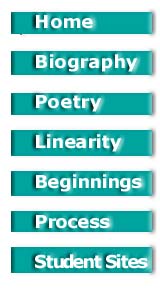Play seems to be a very important element in my students'
hypertext web composing. On our first day in the computer lab,
I like to show them how to add color and images to their lexias.
I love to watch them play with these textual elements. And while
some students then postpone their use of color and images until
later in their composing processes, others seem to rely on color
and images, as well as different fonts, to help them "percolate"
meaning. Such play may postpone the "real" work of
composing and act as a way of helping students learn the technology
they are using. But it could very well be that their play helps
them compose the written language that will end up in their web
projects.
But it doesn't seem to be just color and images that engage
my students in a sense of play. Perhaps it is the kinesthetic
aspect of computing, the movement of the mouse, the sound of
their fingers on the keyboard. Perhaps is a heightened sense
of agency that they experience. Janet Murray
(1997) talks about the increased agency that readers of hypertext
fiction experience. I suspect that my students are feeling that
same increase of agency as writers. The ability to make meaningful
decisions, and see the immediate results of those decisions,
seems to help increase the amount of pleasure they are getting
from the act of composing. Certainly they would rather go to
the computer lab and work on their hypertext projects than stay
in the classroom and work at more mundane language arts activities,
even though those activities are largely student-centered. And
it seems that students working on hypertext projects get more
pleasure out of their composing experiences than my students
did when they used a computer for word processing.
Richard Lanham (1993), of course,
points out that one of the most powerful allures of electronic
text stems from its ability to engage us in play. And Jerome Bruner (1984) argues that children
exhibit their most daring and advanced uses of language when
it occurs in a playful setting.
During a post-project interview with a student who was initially
very resistant to the hypertext projects, I asked her why she
had changed her mind. She said, "It's fun." What I
found powerful about this particular interview was that this
was a very serious student, one who was driven to get top grades
regardless of how much work she had to do or how tedious the
task was that she had to complete.
Play is an important element
in literacy acquisition, and allowing students to play with language,
according to Courtney Cazden (1976) helps them build metalinguistic
awareness. Textual play with color, font, images, and other graphic
elements, then, as well as play with links, allows students to
build a greater awarenessof how written language can be manipulated
and helps build student control over language. And while there
are times when I feel I have to nudge students into, what is
for them, the more mundane aspects of the hypertext web building,
I do not begrudge them the play time they seem to need. Vygotsky
reminds us that play with language helps a child feel "as
though he were a head taller than himself" (1978, 102).
Such play allows a student to feel competent.
This competence, this sense of
agency, is a powerful classroom element, and one that computer
technology seems to enable. It could be the novelty of the computer,
but I sense that something else is going on here. Janet
Murray talks about such agency in her interesting book Hamlet
on the Holodeck (1997) when she points out that immersive
environments such as hypertext enable a sense of agency through
that sense of delight we feel when we can bring about tangible
change. When students create colorful and, to them, attractive
pages with the help of a computer program such as Netscape Composer,
they are actively engaged in meaning-making and behaving as competent
technology users.
